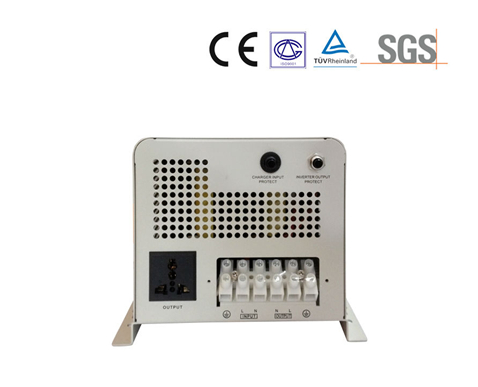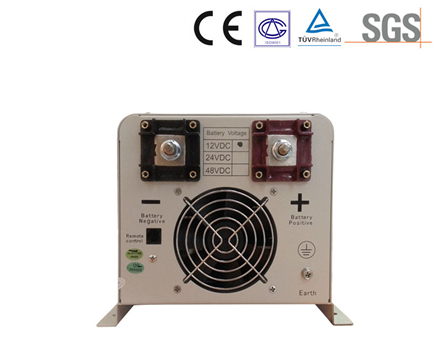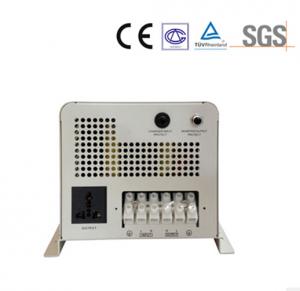Solar Inverter, 3.5kva 24V High Quality/Reasonable Price pure Sine Wave Solar Inverter
- Loading Port:
- Shanghai
- Payment Terms:
- TT or LC
- Min Order Qty:
- 400000 watt
- Supply Capability:
- 3000000 watt/month
OKorder Service Pledge
OKorder Financial Service
You Might Also Like
1. Structure of Solar Inverter, 3.5kva 24V High Quality/Reasonable Price pure Sine Wave Solar Inverter Description
The inverter series is an electronic product that has been designed and built to take low DC woltage power from batteries and convert it to
standard AC power like the current you have at home.
The Inverter series is a DC-to-AC with auto line-to-battery transfer and intergrated charging system. Inverter series powers from ACpower
and DC source, serving as an extended run UPS. When AC cable is connected to a wall socket, utility power goes to connected equipment
and/or charges the battery set via charging system. In Inverter mode, the Inverter series automatically converts battery energy into AC power
for backing up the connected devices.
2. Main Features of Solar Inverter, 3.5kva 24V High Quality/Reasonable Price pure Sine Wave Solar Inverter
• Super efficient, DC to AC conversion, minimizing charging losses
• Input Voltage rangeselect
• 5kva pure sine wave solar inverter
3. Solar Inverter, 3.5kva 24V High Quality/Reasonable Price pure Sine Wave Solar Inverter Images


4. Solar Inverter, 3.5kva 24V High Quality/Reasonable Price pure Sine Wave Solar Inverter Specification
Model | FL-IVP3524-3500VA |
Rated output power | 3500VA |
Max charge current | 35A |
Normal DC input voltage | 24V |
Nominal input power | 110Vac/120Vac/220Vac/230Vac |
Input voltage range | 96~132Vac/155~272Vac |
Charge current regulation | Charge current adjustable:25%,50%,75%,100%(Optional) |
Normal output frequency | 60Hz/50Hz |
Over load protection(SMPS) | Circuit breaker |
Output short circuit protection | Circuit breaker |
Efficiency | >95% |
Output voltage waveform | Pure sine wave |
5. FAQ of Solar Inverter, 3.5kva 24V High Quality/Reasonable Price pure Sine Wave Solar Inverter
Q1:Can we visit your factory?
A1:Sure,welcome at any time,seeing is believing.
Q2:Which payment terms can you accept?
A2:T/T,L/C,Moneygram,Paypal are available for us.
- Q:How does a solar inverter handle reverse power flow?
- A solar inverter handles reverse power flow by automatically detecting the excess power generated by the solar panels and converting it into usable AC power for the electrical grid. It is designed to seamlessly switch between supplying power to the grid and receiving power from it, ensuring efficient utilization of solar energy while maintaining grid stability.
- Q:What is the difference between a central inverter and a string inverter?
- A central inverter is a type of inverter that is used in large-scale solar installations. It takes the direct current (DC) electricity generated by multiple solar panels and converts it into alternating current (AC) electricity that can be used to power homes or businesses. A central inverter is typically located in a central location, such as a utility room or basement. On the other hand, a string inverter is a type of inverter that is used in smaller-scale solar installations. It also converts DC electricity from multiple solar panels into AC electricity, but it does so at the string level. This means that each string of solar panels has its own dedicated inverter. String inverters are usually installed near the solar panels themselves, which can make them more convenient for maintenance and troubleshooting. In summary, the main difference between a central inverter and a string inverter is the scale of the solar installation they are used in and their physical location. Central inverters are used in larger installations and are located centrally, while string inverters are used in smaller installations and are located near the solar panels.
- Q:What is the role of a maximum power point tracker in a solar inverter?
- The role of a maximum power point tracker (MPPT) in a solar inverter is to constantly monitor and adjust the output voltage and current from the solar panels to ensure they are operating at their maximum power point. By tracking and maintaining this optimal operating point, the MPPT increases the overall energy efficiency and power output of the solar system. This is particularly important as solar panel performance can be affected by various factors such as shading, temperature, and varying sunlight intensity.
- Q:What is the role of a surge protector in a solar inverter?
- The role of a surge protector in a solar inverter is to safeguard the inverter and connected electrical equipment from voltage spikes and power surges that can occur due to lightning strikes, grid fluctuations, or other electrical disturbances. It helps to prevent damage to the inverter and ensures the stability and longevity of the solar power system.
- Q:Can a solar inverter be used with different types of power control devices?
- Yes, a solar inverter can be used with different types of power control devices. Solar inverters are designed to convert the direct current (DC) produced by solar panels into alternating current (AC) that can be used to power various electrical devices. They can be integrated with different power control devices such as charge controllers, smart energy management systems, and battery storage systems to optimize the efficiency and performance of the solar power system.
- Q:What is the importance of overcurrent protection in a solar inverter?
- The importance of overcurrent protection in a solar inverter is to ensure the safety and longevity of the system. Overcurrent protection helps prevent damage to the inverter and other components by interrupting the flow of excessive current. It safeguards against potential hazards such as overheating, electrical fires, and equipment failures. Additionally, overcurrent protection helps maintain the efficiency and performance of the solar inverter, ensuring optimal power generation and system reliability.
- Q:How does a solar inverter handle frequency variations in the grid?
- A solar inverter handles frequency variations in the grid by continuously monitoring the frequency and adjusting its own output accordingly. When the grid frequency increases, the inverter reduces its output frequency to match, and vice versa. This helps maintain a stable and synchronized connection to the grid, ensuring efficient power transfer and protecting both the inverter and the grid from potential damage or instability.
- Q:Are there any specific installation requirements for solar inverters?
- Yes, there are specific installation requirements for solar inverters. Here are some key considerations: 1. Location: Solar inverters should be installed in a well-ventilated area, away from direct sunlight or any potential sources of heat. They should also be placed in a clean and dry environment to ensure optimal performance and longevity. 2. Mounting: Inverters can be mounted on walls or placed on flat surfaces, but it is important to follow the manufacturer's guidelines for proper mounting techniques and ensure that they are securely fastened. 3. Wiring: Adequate wiring is essential for connecting the solar panels to the inverter and the inverter to the electrical grid. The wiring should be properly sized, based on the system's specifications, to handle the voltage and current requirements without any voltage drop or overheating. 4. Electrical connections: The inverter should be connected to a dedicated circuit breaker or fuse in the main electrical panel. This circuit breaker or fuse should be properly sized to protect the inverter and the electrical system from any potential hazards. 5. Clearances: Solar inverters require specific clearances to ensure proper ventilation and prevent overheating. The manufacturer's guidelines should be followed to determine the necessary clearances around the inverter. 6. Monitoring and safety devices: Some inverters require additional monitoring and safety devices, such as surge protectors, arc fault circuit interrupters (AFCIs), or rapid shutdown devices. These devices should be installed according to the manufacturer's instructions and local electrical codes. 7. Compliance with regulations: It is crucial to comply with local electrical codes and regulations when installing solar inverters. This may include obtaining necessary permits and inspections to ensure a safe and compliant installation. It is recommended to consult with a professional solar installer or electrician who is knowledgeable about solar inverter installations to ensure that all the specific requirements are met for your particular system.
- Q:How long does a solar inverter last?
- A solar inverter typically has a lifespan of around 10 to 15 years, although this can vary depending on various factors such as the quality of the inverter, its usage, and maintenance.
- Q:How does a solar inverter handle voltage fluctuations from the battery bank?
- A solar inverter handles voltage fluctuations from the battery bank by regulating and stabilizing the incoming DC voltage from the batteries. It converts the fluctuating DC voltage into a stable AC voltage, ensuring a consistent power supply to the connected devices or grid.
1. Manufacturer Overview |
|
|---|---|
| Location | |
| Year Established | |
| Annual Output Value | |
| Main Markets | |
| Company Certifications | |
2. Manufacturer Certificates |
|
|---|---|
| a) Certification Name | |
| Range | |
| Reference | |
| Validity Period | |
3. Manufacturer Capability |
|
|---|---|
| a)Trade Capacity | |
| Nearest Port | |
| Export Percentage | |
| No.of Employees in Trade Department | |
| Language Spoken: | |
| b)Factory Information | |
| Factory Size: | |
| No. of Production Lines | |
| Contract Manufacturing | |
| Product Price Range | |
Send your message to us
Solar Inverter, 3.5kva 24V High Quality/Reasonable Price pure Sine Wave Solar Inverter
- Loading Port:
- Shanghai
- Payment Terms:
- TT or LC
- Min Order Qty:
- 400000 watt
- Supply Capability:
- 3000000 watt/month
OKorder Service Pledge
OKorder Financial Service
Similar products
New products
Hot products
Hot Searches
Related keywords





























